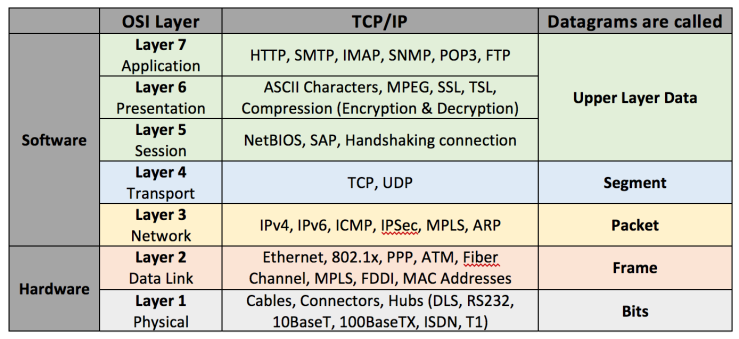Open System Interconnection (OSI) model was developed in 1984, which is a general framework that enables network protocols, software and systems to be designed around a general set of guidelines. Basically, it describes the standards for the inter-computer communication (How does the data get from one computer on one network across cables, connectors and wireless to another computer on another network).

There are many mnemonics way can be used to remember the order of the OSI layer:
- All People Seem To Need Data Processing.
- All People Should Try New Diet Pepsi.
The above sentences can be used to memorise the OSI layers, which uses the first letter of each layer (from the top down) as the first letter of each in the sentence: Application, Presentation, Session, Transport, Network, Data Link and Physical. On the other hand, if you prefer to remember the OSI layers in the opposite order (from the down top), you might need to keep in mind the following sentence:
- Please Do Not Teach Stupid People Acronyms.
- Physical Layer: This is the first layer, which describes the electrical and physical specifications for devices such as, cables, connectors, hubs, repeaters and more. Troubleshooting start in layer one, which means ensure that everything is plugged in, turned on, using the right cables and connectors.
- Data Link Layer: This is the second layer, which works to ensure that the transferred data are free of errors. This layer encompasses basic protocols such as “802.3 for Ethernet” and “802.11 for Wi-Fi”. Note: This layer provides connections between hosts on the same networks.
- Network Layer: This is the third layer, which determines the path of the data packets. At this layer, we can see the IP Addressing for routing of data packets. Also, this layer includes routing protocols such as, Routing Information Protocol (RIP) & the Interior Gateway Routing Protocol (IGRP). Note: This layer provides connections between hosts on different networks.
- Transport Layer: This is the fourth layer that ensures the transport/sending of data is successful. This function can include error checking operation; along with the ability to keep data message in sequence. This layer is an example of an end-to end connections such as Transmission Control Protocol (TCP) & User Datagram Protocol (UDP).
- Session Layer: This is the fifth layer, which identifies the established system session between different network entities. It controls dialogues between computers (3 ways handshaking). For example, when accessing a system remotely, you are creating a session between your computer and the remote system.
- Presentation Layer: This is the sixth layer that provides a translation of data to the next layer (Prepare the data to the Application Layer). Encryption and decryption protocols happen in this layer such as, Secure Socket Layer (SSL). In addition, compression happens in this layer.
- Application Layer: This is the seventh layer, which functions as the user interface platform (including software within the system). For example, the protocols that we interact with on a daily basis such as, Mail, Web (HTTP), FTP and many more.
As an information security and networking specialist/student, it is important to understand the OSI Model for the long-term benefits. Where, in fact, you must learn it and keep it in mind, because it is an essential model for your career and network configuration.